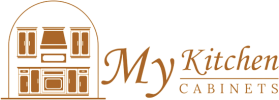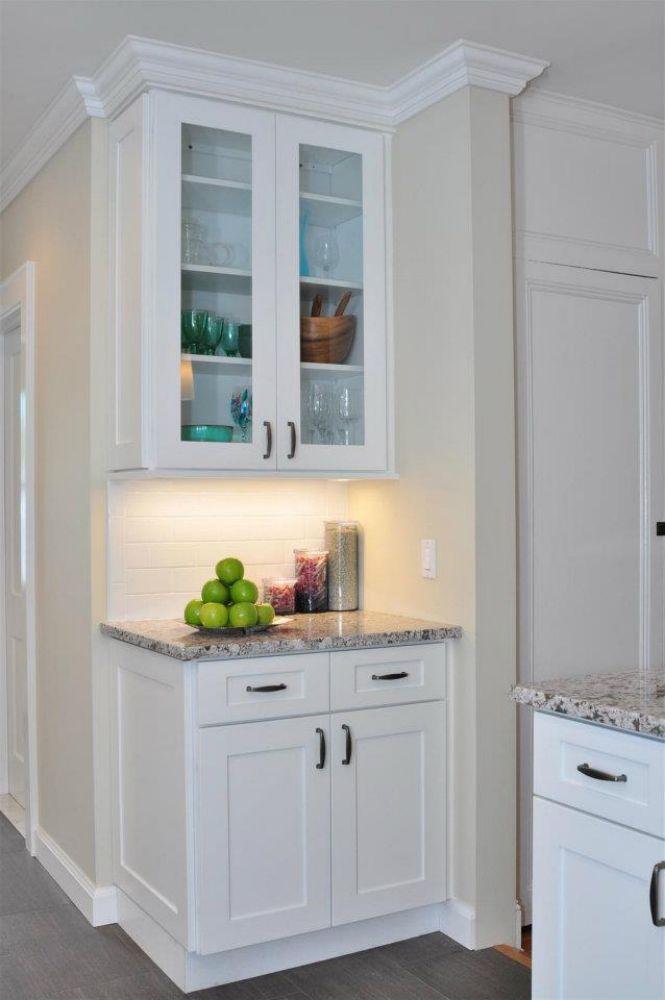The Role of Kitchen Cabinets in Efficient Space Utilization
Every kitchen, regardless of its size, benefits from smart storage design. As modern homes prioritize clean, organized, and multi-functional spaces, the way homeowners use every inch of available area—especially vertical space—has become increasingly important. Among the many design solutions available, tall kitchen cabinets have emerged as a popular choice for those seeking both function and aesthetics.
At My Kitchen Cabinets, we’ve seen a growing trend of homeowners upgrading their kitchens with tall cabinetry that reaches the ceiling or utilizes upper wall space efficiently. These designs not only enhance storage capacity but also lend a sleek, seamless look to modern kitchens. However, are tall cabinets truly the best solution for maximizing vertical storage space, or do they come with trade-offs that should be considered before installation?
This article explores the pros, cons, and design strategies behind tall kitchen cabinets and how to decide if they are the right fit for your home.
Understanding Tall Kitchen Cabinets
1. What Are Tall Kitchen Cabinets?
Tall kitchen cabinets, also known as pantry or tower cabinets, are units that extend vertically—often from the floor up to the ceiling. They can range anywhere from 84 to 96 inches or more in height, depending on ceiling dimensions and customization.
Unlike standard base or wall cabinets, tall cabinets provide full-height storage that can accommodate larger items such as brooms, bulk groceries, or appliances, making them ideal for both compact and expansive kitchens.
2. Types of Tall Kitchen Cabinets
Tall cabinets come in various designs, including:
-
Pantry Cabinets: Full-length cabinets ideal for storing food and dry goods.
-
Utility Cabinets: Designed to hold cleaning tools, mops, or small appliances.
-
Oven or Appliance Towers: Cabinets built to house wall ovens, microwaves, or built-in coffee makers.
-
Combination Towers: Cabinets that integrate drawers, shelving, and pull-outs for versatile storage.
Why Vertical Storage Matters in Kitchen Design
1. Making Use of Unused Space
Most kitchens have untapped vertical real estate between the tops of wall cabinets and the ceiling. Tall cabinets transform that empty zone into functional storage, making every inch count.
2. Improving Organization
Vertical cabinets allow items to be stored by category or frequency of use. For instance, everyday items can be placed at eye level, while seldom-used kitchenware can be stored up high.
3. Reducing Clutter
By increasing storage capacity, tall kitchen cabinets reduce countertop clutter. With more space to hide small appliances, cookware, and pantry items, your kitchen remains neat and visually open.
4. Enhancing Aesthetic Appeal
Tall cabinets create a sense of height and continuity, especially in open-concept layouts. They make the kitchen look more cohesive and can even make low ceilings appear taller when designed with vertical lines.
Advantages of Tall Kitchen Cabinets
1. Maximum Storage Efficiency
Tall cabinets significantly expand storage volume compared to standard wall cabinets. They can hold everything from canned goods to small appliances, freeing up valuable counter and lower cabinet space.
2. Perfect for Compact Kitchens
In small or galley-style kitchens, tall cabinets provide extra storage without increasing the footprint. They allow vertical stacking, which is ideal when horizontal space is limited.
3. Customizable for Specific Needs
Modern tall kitchen cabinets can be customized with pull-out shelves, adjustable racks, built-in drawers, or internal organizers. This flexibility makes them suitable for any storage requirement—from baking supplies to cleaning products.
4. Aesthetic Uniformity
Full-height cabinetry creates a streamlined appearance, eliminating visual breaks between cabinet tops and ceilings. This design contributes to a polished, high-end look.
5. Easy Integration with Appliances
Tall cabinets can be designed to enclose built-in appliances such as ovens, microwaves, or refrigerators. This integration maintains a clean, uncluttered kitchen aesthetic while improving functionality.
Disadvantages to Consider
1. Accessibility Challenges
While tall cabinets maximize storage, the upper shelves can be difficult to reach, especially for shorter users. A step stool or pull-down mechanism is often required to make the highest sections practical.
2. Potential Cost Increase
Taller cabinets require more materials, and if custom-built, they can cost more than standard wall cabinets. However, the added storage and visual impact often justify the investment.
3. Installation Complexity
Installing tall cabinets typically requires precise measurements and professional expertise to ensure they fit perfectly from floor to ceiling—especially in rooms with uneven ceilings or flooring.
4. Visual Weight in Small Kitchens
In some layouts, tall cabinets can make a compact kitchen feel smaller or more enclosed if not balanced with open shelving or lighter finishes.
Comparing Tall Cabinets vs. Standard Cabinets
| Feature | Tall Kitchen Cabinets | Standard Cabinets |
|---|---|---|
| Height Range | 84″–96″ or custom full height | 30″–42″ (wall) + 34.5″ (base) |
| Storage Capacity | Maximum, floor-to-ceiling | Moderate, depends on configuration |
| Best For | Compact kitchens or high ceilings | Medium to large kitchens |
| Aesthetic Appeal | Sleek, modern, continuous look | Traditional or open look |
| Accessibility | Harder to reach upper sections | Easier access to all shelves |
| Installation Cost | Higher | Lower |
| Customization Options | High (can include appliances) | Moderate |
How to Design Tall Kitchen Cabinets for Optimal Function
1. Use a Mix of Open and Closed Storage
Balance tall cabinets with open shelving or glass-front doors. This combination adds visual variety and prevents the kitchen from feeling closed off.
2. Install Pull-Out Systems
To make upper or deep shelves more functional, include pull-out trays, rotating racks, or sliding baskets. These accessories increase accessibility and visibility.
3. Add Integrated Lighting
Interior lighting makes it easier to see contents in deep or tall cabinets. LED strips or motion sensors can be installed for convenience and energy efficiency.
4. Plan for Appliance Integration
Incorporate wall ovens, microwaves, or pantry pull-outs into tall cabinets to create a unified kitchen design. These integrations save counter space and make cooking more ergonomic.
5. Include a Ladder or Step Solution
If you’re installing floor-to-ceiling cabinets, a small, stylish kitchen ladder or pull-out step can make upper shelves practical without compromising aesthetics.
Choosing the Right Materials for Tall Kitchen Cabinets
1. Plywood: Strength and Stability
Plywood remains a top choice for tall cabinets due to its strength and resistance to warping, which is crucial for large, vertical panels.
2. MDF (Medium-Density Fiberboard): Smooth and Versatile
MDF offers a sleek finish ideal for painted cabinets. When properly sealed, it provides durability and affordability.
3. Thermofoil and Laminate Finishes
For a modern aesthetic, thermofoil and laminate finishes offer durability and moisture resistance—ideal for kitchens with frequent humidity and temperature changes.
4. Solid Wood: Classic and Timeless
Solid wood tall cabinets bring natural warmth and luxury but require proper sealing to prevent expansion or contraction.
Style and Finish Options for Tall Kitchen Cabinets
1. Matte Finishes for Modern Sophistication
Matte finishes reduce glare and give a contemporary, understated look. They pair beautifully with natural textures like stone or wood countertops.
2. Glossy Finishes for a Spacious Feel
High-gloss finishes reflect light, making kitchens appear larger. They’re ideal for small kitchens where brightness enhances space perception.
3. Two-Tone Combinations
Use darker tones for tall cabinets and lighter colors for base units (or vice versa) to create visual contrast and depth.
4. Glass-Front Tall Cabinets
For a luxurious look, include frosted or clear glass inserts in tall cabinets to showcase glassware or decorative items.
Maximizing Vertical Space Without Overcrowding
1. Use the Ceiling Height Wisely
If your kitchen has high ceilings, extend cabinetry all the way up but keep less-used items on upper shelves. For standard ceilings, leave a small gap to avoid overpowering the space.
2. Combine with Horizontal Storage
Mix tall cabinets with base drawers or island storage for balance. Too many vertical lines can make a kitchen feel narrow.
3. Consider Corner Tall Units
Corner tall cabinets with rotating shelves (Lazy Susans) make use of otherwise wasted corner space.
4. Add Decorative Tops or Molding
Crown molding or upper trim provides a finished look while covering gaps between the cabinets and ceiling.
Maintenance Tips for Tall Kitchen Cabinets
1. Regular Dusting and Cleaning
Upper cabinet surfaces can accumulate dust or grease. Clean regularly using a gentle degreaser and microfiber cloth.
2. Use Soft-Close Mechanisms
Install soft-close hinges and slides to prevent wear and tear from frequent use.
3. Maintain Lighting Systems
If your cabinets include integrated lighting, check wiring and replace bulbs periodically to ensure safety and visibility.
4. Protect Against Moisture
Seal around sink or stove areas to prevent moisture damage, especially for tall cabinets adjacent to those zones.
When Tall Kitchen Cabinets Are Ideal
Tall kitchen cabinets are perfect for:
-
Small kitchens that need more storage but lack wall space.
-
Open-concept homes that benefit from seamless, ceiling-height designs.
-
Modern or transitional kitchens where clean lines and minimalism are key.
-
Homes with high ceilings that would otherwise have wasted vertical space.
-
Families needing additional pantry or appliance storage.
When Tall Kitchen Cabinets May Not Be the Best Fit
You might reconsider tall cabinets if:
-
You have low ceilings that make them look bulky or cramped.
-
You prefer open shelving or an airy kitchen aesthetic.
-
You want easy accessibility for all items without step stools.
-
You’re working on a tight renovation budget where taller units may exceed costs.
Balancing Tall Cabinets with Other Kitchen Elements
A balanced kitchen design incorporates both vertical and horizontal elements. Combine tall pantry cabinets with:
-
Lower drawers for easy-access cookware storage.
-
Floating shelves for décor or frequently used items.
-
An island with built-in cabinetry for supplementary storage.
This approach maintains functionality while keeping the kitchen visually open and proportionate.
Conclusion
Tall kitchen cabinets are undeniably one of the most effective ways to maximize vertical storage space while maintaining an elegant, cohesive kitchen design. They utilize every inch from floor to ceiling, providing extra room for pantry items, cookware, and appliances—making them a practical choice for both small and large kitchens.
However, to truly benefit from tall cabinetry, homeowners should consider layout, accessibility, and ceiling height to avoid visual clutter or difficult-to-reach storage. When designed strategically—with pull-outs, lighting, and custom organization—tall cabinets not only enhance storage but also elevate the aesthetic and resale value of your home.
At My Kitchen Cabinets, we specialize in providing expertly crafted kitchen cabinets that combine style, functionality, and durability. Whether you want sleek ceiling-height designs or balanced cabinet configurations, our team ensures that your kitchen space is optimized for comfort, beauty, and long-lasting performance.
FAQs
1. Are tall kitchen cabinets suitable for all kitchen sizes?
Yes, tall cabinets work well in most kitchens, especially in small ones where vertical storage compensates for limited floor space. However, careful design is essential to prevent the space from feeling too enclosed.
2. How tall should kitchen cabinets be for an 8-foot ceiling?
For an 8-foot ceiling, 90-inch cabinets leave enough room for crown molding, while 96-inch cabinets can fit flush to the ceiling for a seamless look.
3. Can tall kitchen cabinets replace a traditional pantry?
Absolutely. Tall pantry cabinets can serve as a modern alternative to a walk-in pantry, offering organized shelving and pull-out systems that make stored items easy to access.
4. How do I make tall cabinets more accessible?
You can install pull-down racks, pull-out trays, or adjustable shelving. Some homeowners also integrate rolling ladders or compact step stools for safe access to upper shelves.
5. Are tall kitchen cabinets more expensive?
Typically, yes—taller cabinets use more materials and may require custom installation. However, they offer greater storage capacity and long-term value, often justifying the higher upfront cost.
Read: How do I compare prices across different kitchen cabinets suppliers?
Read: How do I know if kitchen cabinets can be modified after purchase?

